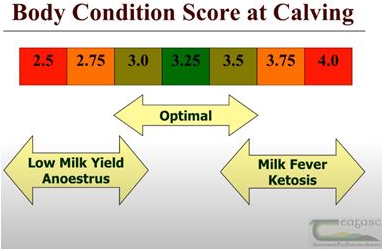Grouping cows when housed this winter, will allow for better management and ensure that they are in the correct body condition score (BCS) for calving.
The dry period for cows is an opportunity to regenerate udder tissue after completing a lactation, and to build condition ahead of calving next spring.
On most farms there will be some cows in better condition than others, and these cows in a lower BCS need preferential treatment.
If these cows fail to get into optimal BSC, it is likely that they will develop issues around calving.

Cows in too high of a BSC can also develop issue around calving, and are more likely to be affected by milk fever or ketosis.
Grouping cows
Getting cows in the correct condition for calving is important, a longer dry period does help – but in some cases concentrates may be required to build adequate condition on cows.
Where possible cows should be grouped in sheds based on their condition score and fed accordingly.
Cows in a BCS that is too low should have ad-lib access to high-quality silage, while cows with a BCS that is too high should have their feed intakes restricted.
Silage quality is going to have a significant impact on what is going to be required to maintain or build condition in your cows.
Getting your silage tested and speaking with your advisor is going to be the best way to determine what is going to be needed.
On farms were there is high quality silage present, you also need to be careful.
High quality feed will add condition to cows, which means that some of the later calving cows may be over-conditioned when it comes to calving.
Along with monitoring cows to ensure they are putting on condition to calve down in the correct BCS, it is important to watch out for cows becoming over-conditioned.
Grouping is going to be the easiest way to monitor cows and ensure that cows are not under, or over-conditioned when calving down in the spring.

